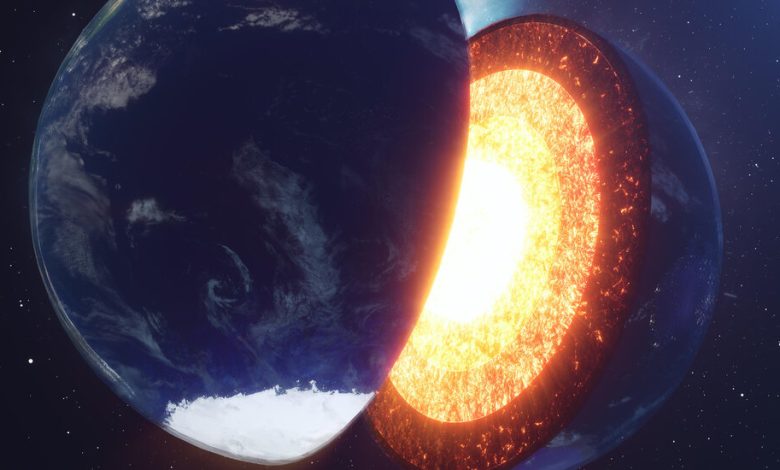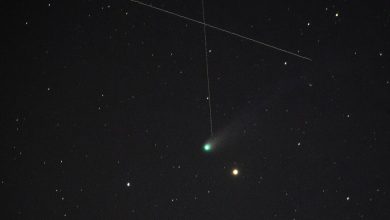Earth’s Inner Core Paused, Then Reversed Its Spin. This Is Fine.

Imagine Earth’s inner core — the dense center of our planet — as a heavy, metal ballerina. This iron-rich dancer is capable of pirouetting at ever-changing speeds.
That core may be on the cusp of a big shift. Seismologists reported Monday in the journal Nature Geoscience that after brief but peculiar pauses, the inner core changes how it spins — relative to the motion of Earth’s surface — perhaps once every few decades. And, right now, one such reversal may be underway.
This may sound like a setup for a world-wrecking, blockbuster movie. But fret not: Precisely nothing apocalyptic will result from this planetary spin cycle, which may have been happening for eons. The researchers who propose this speculative model instead aim to advance understanding of Earth’s innermost sanctum and its relationship with the rest of the world.
The inner core is like “a planet within a planet, so how it moves is obviously very important,” said Xiaodong Song, a seismologist at Peking University in Beijing and an author of the study.
In 1936, the Danish seismologist Inge Lehmann discovered that Earth’s liquid outer core envelops a solid metal marble — and it has bamboozled scientists ever since.
“It’s weird that there’s a solid iron ball kind of floating in the middle of the Earth,” said John Vidale, a seismologist at the University of Southern California who was not involved with the study. Scientists think the core crystallized out of a molten metal soup at some point in Earth’s not-too-distant past, after the planet’s internal inferno had sufficiently cooled.
The inner core cannot be directly sampled, but energetic seismic waves emanating from potent earthquakes and Cold War-era nuclear weapon tests have ventured through the inner core, illuminating some of its properties. Scientists suspect this ball of mostly iron and nickel is 1,520 miles long and as about as hot as the sun’s surface.
But these waves also created a conundrum. If the core was inert, the voyages of core-diving waves coming from near-identical quakes and nuclear explosions would never change — yet, over time, they do.
One explanation: The inner core is spinning, deflecting these waves. In the mid-1990s, Dr. Song was one of the first scientists to suggest that the inner core may be rotating at a different speed than Earth’s surface. Since then, seismologists have found evidence implying the inner core’s spin can both speed up and slow down.
What’s going on? One idea is that two titanic forces are battling for control over the world’s heart. Earth’s magnetic field, generated by swirling iron currents in the liquid outer core, is pulling at the inner core, causing it to spin. That impulse is countered by the mantle, the mucilaginous layer above the outer core and below Earth’s crust, the immense gravitational field of which grasps the inner core and slows its spin.
By studying core-diving seismic waves recorded from the 1960s to the present day, Dr. Song and Yi Yang, another Peking University seismologist and a co-author of the study, posit that this tremendous tug of war causes the inner core to spin back and forth on a roughly 70-year cycle.
In the early 1970s, relative to someone standing on Earth’s surface, the inner core was not spinning. From then, the inner core has gradually spun faster eastward, eventually overtaking the speed of rotation of Earth’s surface. Afterward, the inner core’s spin decelerated until its rotation appeared to have stopped at some point between 2009 and 2011.
The inner core is now starting to gradually spin westward relative to Earth’s surface. It will likely accelerate then decelerate once again, reaching another apparent standstill in the 2040s and completing its latest eastward-westward spin cycle.
This 70-year rhythm, if it exists, could have a tangible effect on parts of Earth’s deeper viscera. But it may only be capable of stirring up comparatively minor turbulence closer to the surface — perhaps by causing subtle shifts in the planet’s magnetic field, or even by very slightly tweaking the length of a day, which is known to go increase and decrease by a fraction of a millisecond every six years.
This is just one of several competing models explaining the erratic voyages of waves that reach the core. It is also possible that Earth’s innermost layer is wobbling about. Conversely, Earth’s ferrous nucleus may have a metamorphosing surface, twisting any seismic waves that pierce it. “No matter which model you like, there’s some data that disagrees with it,” Dr. Vidale said.
Because of its inaccessibility, this abyssal realm may forever elude explanation. “It’s certainly possible we’ll never figure it out,” Dr. Vidale said. But, he added, “I’m an optimist. The pieces are going to fall into place someday.”





